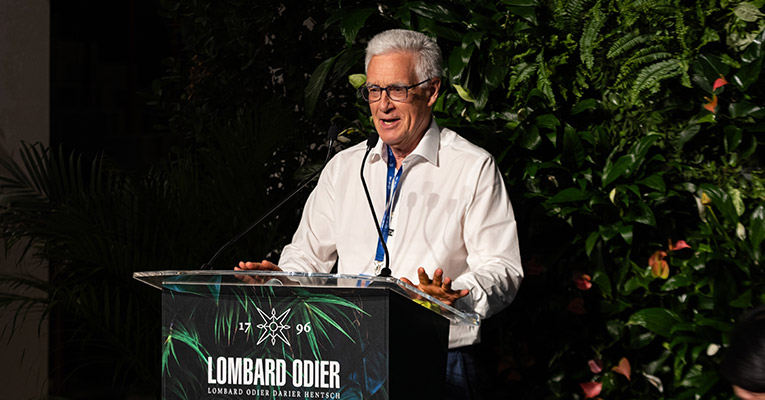rethink sustainability
Industry Day puts cities and energy in the spotlight at the re-NATURE Hub at COP28

The transition to zero-carbon energy is top of the agenda at COP28. Already, just days into the conference, more than 100 countries have pledged to triple global renewable energy capacity by 2030, the EU has announced EUR 2.3 billion in investment in renewable energy infrastructure, and the US has promised to close all its coal-fired power stations by 2035.
Discover the highlights from the Industry Day at our re-Nature Hub at COP28:
As the zero-carbon momentum builds, Industry Day at our COP28 re-NATURE Hub saw global experts from across finance, industry and government gather to explore the unprecedented opportunities arising as the world moves away from fossil fuels, and to ask what the built environment – the world’s biggest asset class – can learn from the energy sector, as it plays catch up in the race to net zero.
A transition chain reaction
Opening the day’s event, Hubert Keller, our Senior Managing Partner, told delegates that the shift from fossil fuels to zero-carbon renewable energy constitutes “a complete rewiring of our economy.” “From an investment perspective,” he said, “we think this will be the biggest and most profound economic transformation of all time.”
The speed of the change, he said, has been underestimated. Where markets had forecast linear growth, we are now seeing exponential growth, and are “on course to invest USD 3-3.5 trillion into the electrification of the world’s energy systems, a similar sum to that invested into the IT revolution over the last decade. We are witnessing a coalition of technologies that are triggering a transition chain reaction.”
Read also: Building Bridges 2023: an EUR 2 trillion opportunity as the economy goes electric | Lombard Odier
“But the transformation of the energy system,” he said, “is not just about energy. It’s affecting all parts of our economy that rely on energy – like mobility. This economic disruption will disrupt the built environment as well. When you think about the investment going into this proposition it becomes irresistible. We are at the beginning of a big investment cycle.”
Reaching net zero – mission possible
Lord Adair Turner, Chair of the Energy Transitions Commission, picked up on Hubert Keller’s theme. The exponential growth of clean energy, he said, is best seen in solar panels. “In 1970 a solar panel cost USD 100 per watt of power output. The latest figure is USD 0.12 per watt. And it’s going to get cheaper. Solar installation is going far faster than anyone thought would be achieved.”

Crucially, “[battery] energy density is going up by 10% per year.” This progress, he said, means that long-distance battery-powered aviation will one day be possible. It is also making the rise of electric vehicles (EVs) unstoppable. “By the mid-2030s, 90% of car sales will be EV,” he said. “And this is going to trucks too. Volvo will sell no diesel or petrol trucks by 2040. The internal combustion engine is dead, we just haven’t quite buried it yet.”
Electrification is cutting across other sectors, too, he said, with “unstoppable technologies which have gone beyond tipping points.” “Hydrogen steel” – steel made using hydrogen produced from clean electricity – “is already proven, and will be in full production by 2027. By 2032, Swedish Steel will close all coke-fired [steel] plants.”
In construction, too, he explained, we have the zero-carbon solutions we need. For example cement, which is responsible for 8% of all man-made carbon emissions1, will one day deploy carbon capture and storage technology. However, he warned, this will not happen by innovation alone. To achieve it “you need carbon prices and regulation, mandates that will drive us towards the solutions that are already technologically available.”
Real estate plays catch-up
The importance of regulation was echoed in a panel on the built environment, as industry experts explored why the sector – the world’s largest asset class – is lagging other sectors in reducing emissions.
Moderator Katherine Stodulka, a Partner at Systemiq, noted that any transformation of the global economy will be incomplete without a fundamental change in real estate, which is worth USD 380 trillion (4 times global GDP), and is responsible for 40% of the world’s energy-related emissions. Further, she warned, the total floor area of the world’s buildings will increase 15% by 2030, with most of the growth taking place in emerging markets. Even as the sector grows, she said, “energy intensity will need to fall five times more quickly. We are seeing huge growth that needs to be decoupled from energy intensity.”

Alan Organschi, Partner at Gray Organschi Architecture, explained that we already have the means to build in a way that is not only net-zero, but can even be climate-positive. By using materials from sustainably-managed forests “we can avoid emissions, build dense cities and sequester carbon. We can decarbonise concrete. And by using other materials we can sink carbon and store it in the system on a massive scale.”
Mikkel Bülow-Lehnsby, co-founder of Urban Partners, agreed, but repeated Lord Turner’s call for regulation. “There is no physical reason why buildings shouldn’t be carbon sinks and also increase biodiversity,” he said. “We can build all buildings net zero tomorrow, but we need systems change, regulatory change.”
Tackling a giant
Brune Poirson, Chief Sustainability Officer at Accor, Europe’s largest hospitality company, highlighted the deep disruption that the transition is bringing to the hotel and travel sector. One solution, she said, may be to “move away from volume and quantity, in favour of quality,” which, for some firms, would be a fundamental change to business models.
For large hospitality firms, she said, a leap to carbon neutrality is near impossible. Instead, the hotel industry can tackle the built environment’s giant emissions by “maximising use of the space.” “So we are turning our lobbies into a physical market place. Perhaps we could even welcome kindergartens into them,” she suggested.
Further challenge will come from tourism demand, which is both highly concentrated and growing. “95% of people who travel go to 5% of the world’s places. Travel and tourism is only going to grow,” she said. “So we need pressure from regulators, and we need to be involved early in the decision-making process.”
Discover our video with Brune Poirson, Chief Sustainability Officer at Accor:
Joy Gai, Programmes Head for the Asia Pacific region at the World Green Building Council, agreed that the giant won’t be slain overnight. However, she said, “we are feeling the pressure, which is good.” Asia Pacific is “taking lessons from the rest of the world and duplicating them across the region.” For sustainable change, she noted, the solution couldn’t only be technological – communities have to be connected to the built environment. “This is the only economic sector we call home,” she said. “As well as decarbonising, social sustainability also comes in increasing health and wellbeing.”
Discover our video with Joy Gai, Programmes Head for the Asia Pacific region at the World Green Building Council:
Investing for the long-term
When it comes to building the investment case for a green transformation in real estate, Anthony Taylor, Senior Executive Officer at Masdar Green Real Estate Investment Trust, amplified the call for regulations. “What you need is carrot and stick from governments and regulators,” he said. “You need to be pushed along but also have incentives.”
In developed markets, he said, this regulation is further ahead. In the EU, for instance, from 2028 all new buildings will have to be zero-emissions in their ongoing operations. For Hubert Keller, the potential for strict new regulations is creating a major risk of “stranded assets”. “Zero emissions new builds, including embodied emissions, will totally disrupt real estate, materials and construction,” he said. Vast numbers of so-called “brown buildings” – those that score poorly on energy efficiency metrics – will find themselves without commercial clients, while buildings that score highly on both energy efficiency and embodied carbon will find ever greater commercial and investment demand.
For renewable energy investors, Thomas Hohne-Sparborth noted, it has been a difficult year on public markets. “Most clean energy funds are down,” he acknowledged, following interest rate rises that have hit the sector hard. However, looking beyond these cyclicals, the “underlying superior engineering” will ensure the long-term strength of the sector.
Concluding, Lord Turner emphasised this difference between market cycles and underlying trends. The sustainability transition itself will not be a one-way street – there will be both winners and losers. Transformative technologies, he highlighted, can cause market swings. The key for investors is to “focus on understanding the fundamental technological and social changes that are occurring, and to take the long view that goes beyond the inevitable cycles.”
1 Climate change: The massive CO2 emitter you may not know about - BBC News
Important information
This document is issued by Bank Lombard Odier & Co Ltd or an entity of the Group (hereinafter “Lombard Odier”). It is not intended for distribution, publication, or use in any jurisdiction where such distribution, publication, or use would be unlawful, nor is it aimed at any person or entity to whom it would be unlawful to address such a document. This document was not prepared by the Financial Research Department of Lombard Odier.
Read more.






share.